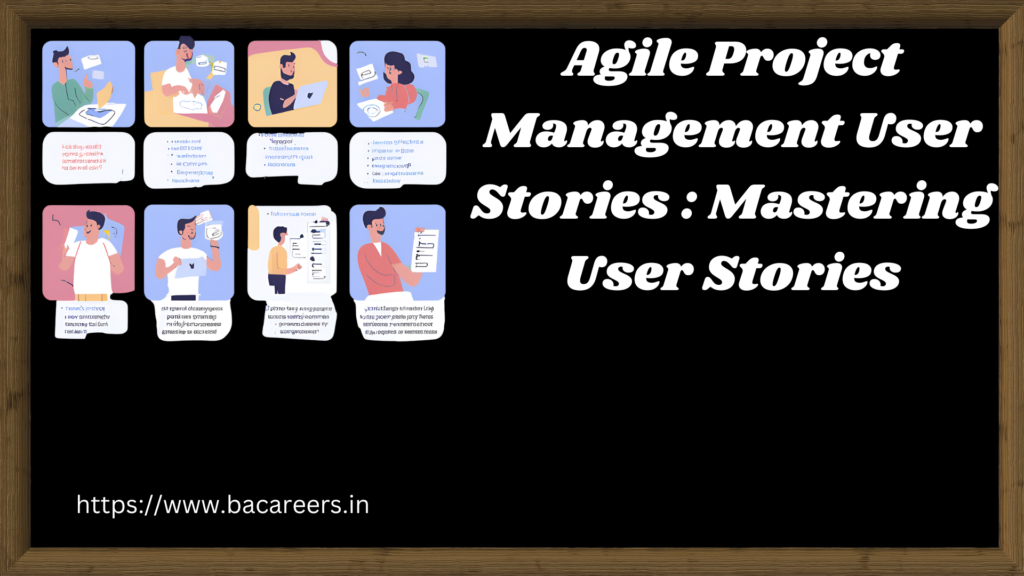Agile Project Management User Stories : Agile project management has transformed how teams deliver software, emphasizing collaboration, flexibility, and customer satisfaction. At the heart of Agile are user stories, concise descriptions of a feature from the end user’s perspective. This article will explore what user stories are, provide examples and templates, and offer tips on crafting the best user stories for your projects.

What are User Stories in Agile?
User stories are short, simple descriptions of a feature told from the perspective of the person who desires the new capability, usually a user or customer. They are a cornerstone of Agile project management, helping teams understand the user’s needs and prioritize work effectively.
Key Components of a User Story
A standard user story follows the template:
“As a [type of user], I want [an action] so that [a benefit/a value].”
This structure ensures clarity by identifying who the user is, what they want, and why they want it.
Examples of Agile Project Management User Stories
Example 1: E-commerce Website
User Story: “As a shopper, I want to filter products by price range so that I can find items within my budget.”
Example 2: Mobile Banking App
User Story: “As a user, I want to view my transaction history so that I can keep track of my spending.”
Example 3: Online Learning Platform
User Story: “As a student, I want to access course materials offline so that I can study without an internet connection.”
Agile Project Management User Stories Template
Using a template can streamline the process of writing user stories. Here’s a versatile template to guide you:
User Story Template:
Title: [Short, descriptive title]
As a [type of user], I want [an action or feature] so that [a benefit or value].
Acceptance Criteria:
- [Condition 1]
- [Condition 2]
- [Condition 3]
Example with Template
Title: Filter Products by Price
As a shopper, I want to filter products by price range so that I can find items within my budget.
Acceptance Criteria:
- The user can select a minimum and maximum price.
- The filtered results update dynamically as price inputs change.
- The price filter is displayed prominently on the product listing page.
Best Practices for Writing User Stories
Creating effective user stories requires more than just filling out a template. Here are some best practices to consider:
- Be Clear and Concise: User stories should be easy to understand without any ambiguity.
- Focus on the User: Always write from the user’s perspective to ensure the feature delivers real value.
- Include Acceptance Criteria: Define what must be true for the story to be considered complete.
- Keep Stories Small: Break down large features into smaller, manageable stories that can be completed in a single iteration.
- Collaborate with Stakeholders: Involve users, product owners, and developers in writing and refining user stories to ensure all perspectives are considered.
How to Write a User Story
Writing a user story involves understanding the user’s needs and translating them into a feature that delivers value. Here’s a step-by-step guide:
- Identify the User: Determine who will benefit from the feature.
- Define the Action: Specify what the user wants to do.
- State the Benefit: Explain why the user wants to perform this action.
- Write Acceptance Criteria: Outline the conditions that must be met for the story to be complete.
Example Walkthrough
Let’s create a user story for a task management app:
- Identify the User: Project Manager
- Define the Action: Create a task
- State the Benefit: To organize work and delegate responsibilities
User Story: “As a project manager, I want to create tasks so that I can organize work and delegate responsibilities.”
Acceptance Criteria:
- The user can enter a task name and description.
- The user can assign the task to a team member.
- The user can set a due date for the task.
Conclusion
User stories are a fundamental element of Agile project management, offering a user-centric approach to defining and prioritizing work. By using templates and following best practices, you can ensure your user stories are clear, actionable, and valuable to your end users. Remember, the goal is to create features that truly meet the needs of your users, driving satisfaction and success for your projects.

Business Analyst , Functional Consultant, Provide Training on Business Analysis and SDLC Methodologies.
Author: Pallavi
Business Analyst , Functional Consultant, Provide Training on Business Analysis and SDLC Methodologies. View all posts by Pallavi

Hello there, just was alert to your blog through Google, and found that it is truly informative. I am going to be careful for brussels. I抣l appreciate if you happen to continue this in future. A lot of people will probably be benefited out of your writing. Cheers!
Attractive section of content I just stumbled upon your blog and in accession capital to assert that I get actually enjoyed account your blog posts Anyway I will be subscribing to your augment and even I achievement you access consistently fast
Fantastic site A lot of helpful info here Im sending it to some buddies ans additionally sharing in delicious And naturally thanks on your sweat
Wow wonderful blog layout How long have you been blogging for you make blogging look easy The overall look of your site is great as well as the content